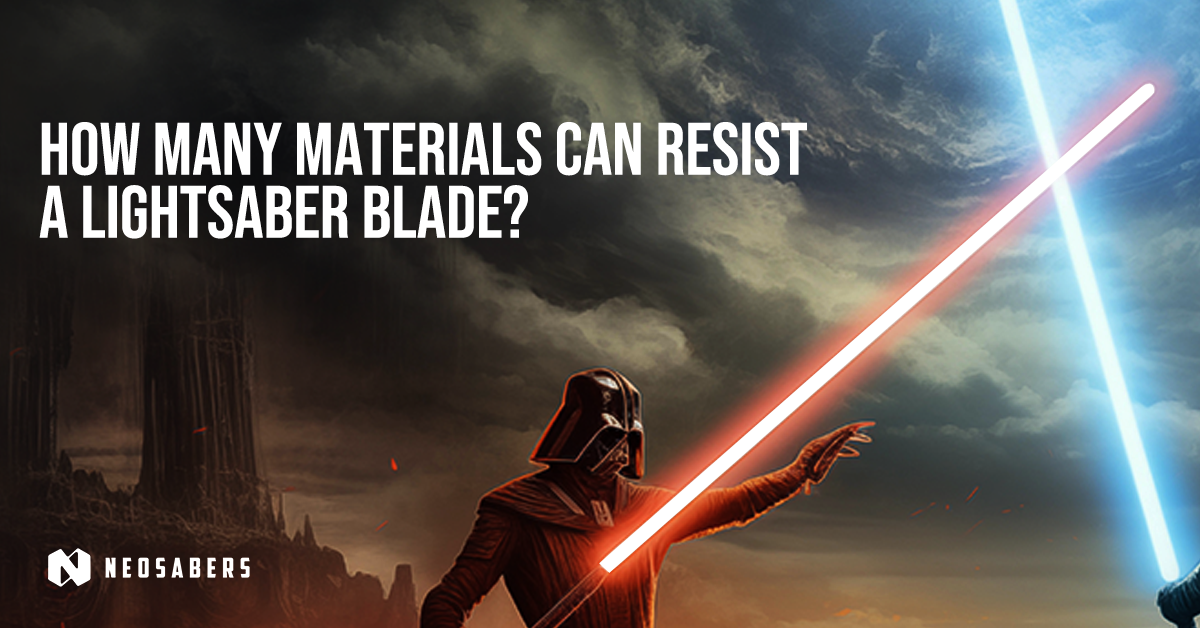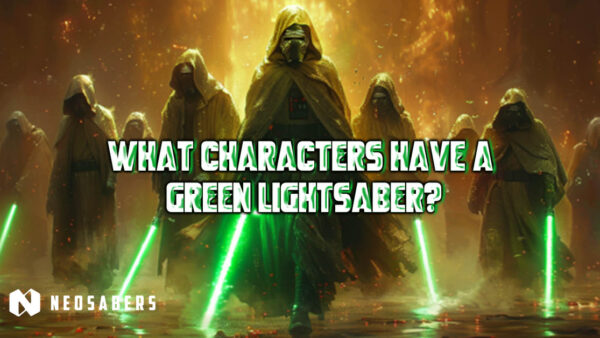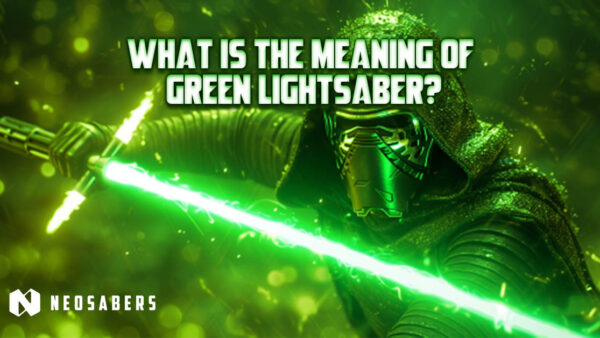Ever since we first saw lightsabers in action, we’ve been captivated by their sheer awesomeness. These glowing blades have the ability to cut through almost all the materials in the galaxy. But here is the real question: What can actually stand up to a lightsaber’s sizzling power?
Image source: Wookieepedia-Fandom
In this blog, we are diving deep into the world of lightsabers to uncover the materials that can resist their fiery blades. It is like solving a cosmic puzzle with a hint of sci-fi magic.
Come, join us as we delve into the materials that are resistant to the famous weapon used by the Jedi and the Sith. The adventure ahead will combine elements of science fiction and real science, creating an unforgettable experience.
EVERY LIGHTSABER-RESISTANT MATERIALS
Lightsabers are widely recognized as one of the most dangerous weapons ever employed. These deadly laser swords, when in the hands of a skilled user, can slice through almost anything, making them a formidable force to reckon with. But what if we told you that there are materials out there that can defy the fiery wrath of a lightsaber blade?
Image source: Quora
Lightsabers are intimately tied to the Force, both the light and dark sides of it. The crystals that power these formidable weapons, known as Kyber Crystals in canon, play a pivotal role.
Legends even delve into the creation of “synth crystals” through the fusion of tools and the Force. This connection suggests that materials capable of resisting lightsabers might also have some link to the Force.
Unconventional Defenses against Lightsaber
In the Star Wars universe, the threat of lightsabers has led to the creation of ingenious defensive measures. Take, for instance, the thick blast doors encountered in “The Phantom Menace.” Despite their formidable appearance, Qui-Gon Jinn effortlessly sliced through them with his lightsaber. The only effective countermeasure in the prequel trilogy was the use of ray shields, which would absorb the energy of a lightsaber blade.
The discovery of lightsaber-resistant materials has not gone unnoticed by the galaxy’s factions. Not only have Jedi and Sith employed them in their quests for power, but groups like the Mandalorian and the formidable Yuuzhan Vong empire have also recognized their value in countering lightsaber-wielding adversaries. These materials have become coveted assets in the ongoing struggle for dominance.
A Diverse Arsenal of Resistance
Lightsaber-resistant materials come in a fascinating array, from rare metallic ores to the hides and shells of creatures with Force connections. Some substances even hail from distant galaxies, a testament to the lengths beings have gone to defend against lightsabers.
These materials vary in their effectiveness, with some offering temporary resistance, others a lasting defense, and a few causing lightsabers to malfunction upon contact.
Mandalorian Beskar is widely recognized as a substance that cannot be sliced by a lightsaber. This extraordinary metal, renowned for its strength and resilience, can withstand the searing power of a lightsaber.
It is no wonder that Mandalorian warriors often crafted their armor from this exceptional substance, providing them with unparalleled protection.
Image source: Quora
STAR WARS ENTHUSIASTS!
As we explore the secrets of lightsaber-resistant materials, we will journey deeper into the heart of Star Wars lore and science fiction. These materials stand as a testament to the creativity and complexity of the galaxy far, far away, where the clash between ancient weapons and rare defenses continues to shape its destiny.
Beskar
The material known as Beskar holds great significance in Mandalorian culture due to its legendary resistance to lightsabers. The metal represents the Mandalorian way of life, not just a mere symbol.
You have probably seen it in action, adorning the iconic Mandalorian armor worn by renowned figures like Boba Fett, Din Djarin, and Sabine Wren. This remarkable metal has a rich history intertwined with the Mandalorian clans and their enduring conflict with the Jedi.
Image source: Wookieepedia-Fandom
The Unbreakable Metal of Mandalore
Mandalorian have a special affinity for Beskar, crafting their armor from it for generations. The reason? Lightsabers. Throughout a significant period of time, the Mandalorians have engaged in conflict with the Jedi. To stand their ground, they wear armor made of Beskar, offering protection against the deadliest weapon in the galaxy.
The oppressive Galactic Empire sought to crush Mandalorian resistance, leading to the seizure of Beskar and the deaths of many Mandalorian. Din Djarin, our beloved Mandalorian protagonist, embarked on a mission to reclaim Beskar after the fall of the Empire.
Image source: Quora
During the Galactic Civil War, Sabine Wren, once an Imperial agent, played a pivotal role in the Beskar story. She invented a powerful weapon that could potentially destroy Beskar and those who wear their armor. However, her allegiance shifted as she joined the Rebellion, and she took it upon herself to destroy the weapon, eliminating any chance of its resurrection.
Symbol of Mandalorian Resilience
Beskar’s uses go beyond armor; it’s a versatile material. Magistrate Morgan Elsbeth demonstrated this when she wielded a Beskar staff, allowing her to stand her ground against the formidable Ashoka Tano for a brief but intense showdown.
Mandalorians Darksaber used Beskar to make various items such as gauntlets, blades, swords, manacles, and musical instruments.
Yes, you read that right—musical instruments are designed to double as lethal weapons. Mandalorian truly epitomizes the concept of being ready for anything.
Beskar isn’t just a metal; it’s a symbol of resilience, a testament to the enduring spirit of the Mandalorian people. As we delve deeper into the galaxy’s secrets, Beskar remains an enduring icon, a reminder that even in a universe filled with the extraordinary, some things are unbreakable.
Zillo Beast Hide
In the vast Star Wars galaxy, there’s one more natural material that stands tall against lightsaber strikes – the hide of the colossal Zillo Beast. Imagine a creature akin to Godzilla, but with scales so impenetrable that even lightsabers bounce off them effortlessly.
Introduced in “Star Wars: The Clone Wars,” the Zillo Beast’s hide is a remarkable rarity, mostly due to the near-extinction of these titanic creatures.
Image source: Wookieepedia-Fandom
The Zillo Beast’s Origins: A Force Connection?
Native to the planet Malastare, these gargantuan reptiles boast armored plating that seems impervious to lightsabers. However, while they may be tough, they’re not invincible. Zillo Beasts have a vulnerability to a specific toxin used by the Dug species, a testament to the intricate balance in the Star Wars universe.
Someone woke up a Zillo Beast during the Clone Wars. People thought it was the last one of its kind. This creature’s natural resistance to lightsabers piqued the interest of none other than Chancellor Palpatine himself.
Emperor Palpatine, always scheming, even proposed the idea of cloning the beast to harness its hide for production purposes, demonstrating the allure of lightsaber-resistant materials in the galaxy.
Image source: Reddit
What’s even more intriguing is the Zillo Beast’s possible connection to the Force. Some believe that these colossal creatures possess a unique sensitivity to the Force, which could explain their uncanny ability to resist lightsaber attacks. In fact, during the Clone Wars era, the Zillo Beast seemed to sense the true nature of Chancellor Palpatine, making it a creature of not just physical might but also spiritual awareness.
A Dark Resurgence: The Zillo Beast’s Clone
Despite their seemingly invulnerable hides, Zillo Beasts can meet their end, as demonstrated in the Clone Wars when Clone Pilots used dug toxins to take one down. And in a curious twist, another Zillo Beast, potentially a clone secretly ordered by Palpatine, met its demise on Benathy at the hands of Kylo Ren.
Kylo Ren’s method was unconventional, bypassing the creature’s formidable hide to strike at its heart, further underscoring the mystique of these incredible beings.
The Zillo Beast and its lightsaber-resistant hide add another layer of complexity to the Star Wars universe. It’s a reminder that even in a galaxy filled with extraordinary phenomena, there are marvels waiting to be uncovered, each with its own unique story.
Lightsaber-Resistant Armors
Beskar Armour
In a galaxy where lightsaber-resistant materials are already a scarcity, finding armors boasting this unique trait is an even greater rarity. However, there’s one standout example that has made its mark in the Star Wars universe, and it takes center stage in “The Mandalorian.”
Image source: IGN
Din Djarin’s Beskar Armor: A Marvel of Resilience
The most prominent illustration of lightsaber-resistant armor comes from the character Din Djarin, famously known as the Mandalorian. While typical Mandalorian armor incorporates only small amounts of Beskar, Din’s suit is an exception. Crafted from pure Beskar, it stands as a testament to the incredible durability of this legendary metal.
Din Djarin’s Beskar armor shows off its amazing strength and resistance throughout the events of “The Mandalorian” Season 2. Notably, it withstands direct strikes from Ashoka Tano’s lightsabers, a testament to the potency of this lightsaber-resistant material.
READ ALSO: Mandalorian S3 Premier with NEO Sabers
But the true spectacle unfolds as Din confidently strides down corridors, deflecting blaster shots with ease. This Beskar armor is more than just protective; it is practically impenetrable.
It is safe to declare that Din Djarin’s armor ranks among the most robust and resilient in the galaxy, serving as a symbol of the Mandalorian way and their unyielding resolve.
Image source: 3D Cauldron
While Beskar remains the primary source of lightsaber-resistant armor in the Star Wars universe, the rarity of such armors makes them highly coveted. The Mandalorian’s Beskar armor serves as a shining example of how a unique material can elevate not just a character’s protection but also their legendary status.
Cortosis Armor
In the expansive Star Wars Legends lore, one material stands out as a formidable defense against lightsabers: cortosis. This precious substance, though exceptionally rare and challenging to mine effectively, has played a vital role in countering the prowess of Jedi and Sith throughout the galaxy’s history.
Image source: Star Wars-Obsidian Portal
The Versatility of Cortosis: Two Unique Varieties
Depending on its refinement, cortosis can manifest in two distinct forms, each with its own remarkable attributes and effects on lightsabers.
1. Resistant Cortosis: Holding the Line
- In its first variation, cortosis resists lightsaber blades, providing a sturdy defense. While it can withstand repeated strikes to a certain extent, it’s not impervious, and a persistent lightsaber attack will eventually breach its defenses.
- During the Clone Wars era, the Confederacy of Independent Systems (CIS) employed this type of cortosis in the armored shell of their Techno Union’s C-B3 Cortosis Battle Droids.
- The Empire Reborn faction of the Imperial Remnant later utilized cortosis to craft suits of armor for their dark side-using Shadow troopers, who wielded lightsabers. These powerful enemies attacked Luke Skywalker’s Jedi Academy on Yavin IV.
2. Cortosis Armor: A Deadly Reversal
- The second variation of cortosis takes a different approach. Instead of blocking lightsabers outright, it temporarily deactivates them upon contact. Lightsabers struck by this type of cortosis may flicker and shut down for a brief period, leaving their wielders vulnerable.
- Cortosis armor, made from the rare cortosis metal found on the planets Dinzo and Mokivj, is a prime example of this variant. While the metal itself is fragile and unsuitable for common armor, it possesses a unique capability – the ability to absorb and redirect high amounts of energy. When a lightsaber strikes this armor, the energy is rebounded, occasionally causing the lightsaber to overload and power down.
Image source: Screen Rant
While cortosis enjoys a more prominent role in Star Wars Legends, its presence in the canon is comparatively limited. Nevertheless, it still manages to leave its mark in stories like the novel “Thrawn: Alliances,” where a Separatist plot involving cortosis armor for droids and Republic Clone Trooper armor is thwarted by Anakin Skywalker, Padmé Amidala, and the strategic genius Thrawn.
Phrik
Phrik possesses a unique characteristic: it can be molded when molten but solidifies into one of the galaxy’s most formidable and durable substances. This dual nature, combined with its lightsaber-blocking capabilities, made phrik highly coveted despite its rarity and steep cost.
Image source: Pinterest
Phrik’s Exceptional Traits
Phrik stands out as a superior alternative to even cortosis, renowned for its lightsaber-resistant properties. When phrik transitions into a solid state, it becomes astonishingly resilient, capable of withstanding the fiercest lightsaber strikes.
The wealth amassed by the corrupt corporate oligarchy within the Confederacy of Independent Systems (CIS) granted them access to phrik’s power. They equipped General Grievous’ fearsome IG-100 Magna Guards with phrik electro staffs, transforming these droids into formidable adversaries with lightsaber-resistant capabilities. In battles against Jedi and Clone Troopers, the IG-100 Magna Guards demonstrated the formidable might of their phrik weaponry.
Phrik for Lightsabers and Armor
Even Emperor Palpatine recognized Phrik’s value. He chose to construct his lightsaber hilt from this resilient material, ensuring his weapon’s protection against lightsaber-wielding adversaries. As the ruler of the Galactic Empire, he wielded vast resources, leading to the integration of phrik into the weaponry and armor of experimental Dark Troopers.
Image source: Screen Rant
Phrik’s durability extends beyond weaponry and armor. Bail Organa, a prominent figure in the Rebel Alliance, safeguarded a precious Jedi Holocron within a phrik safe. Remarkably, this sturdy container endured the catastrophic destruction of Organa’s home world, Alderman.
In the Star Wars canon, the Knight of Ren known as Vicrul wielded a phrik scythe as his signature weapon, highlighting the enduring relevance of phrik even in the revised narrative.
Orbalisk: The Dark Side-Hungry Parasitic Armor
Deep on the mysterious planet Dxun, curious creatures known as orbalisks thrive. They’re not your typical beings; instead, they’re parasites with a real taste for the Dark Side’s power.
Image source: Quora
These orbalisks don’t go solo. They gather in packs and seek companionship. Once they find a victim, they start their strange process of taking over.
What makes orbalisk armor special is how tough it is. Even lightsabers, those fancy laser swords Jedi and Sith use, can’t cut through it. It’s like they have an invisible shield.
But like all cool stuff, orbalisks have a weakness. They don’t like electricity. Even with their super-strong armor, a good jolt of electricity can stop them.
Orbalisks are just one of the many weird and wonderful creatures in the Star Wars galaxy. They’re a reminder that even in a world of incredible powers and tough armor, there’s always something that can stop you in your tracks.
Elite Praetorian Guard: Masters of Lightsaber-Resistant Gear
When Supreme Leader Snoke of the First Order gathered his loyal protectors, he had one crucial expectation – they must be prepared to face lightsaber-wielding adversaries. To meet this daunting challenge, the Elite Praetorian Guards were equipped not just with combat skills, but with armor and weapons engineered to resist the searing power of lightsabers.
Image source: The Toyark
As we’ve witnessed throughout the Star Wars saga, powerful energy fields, akin to force fields, possess the ability to thwart lightsaber strikes. The armor donned by the Elite Praetorian Guards might not be crafted from traditional lightsaber-resistant materials, but it conceals a miniature energy shield within its structure, offering a degree of protection against these iconic weapons.
This additional layer of defense, however, comes at a price – the armor is exceptionally uncomfortable to wear. Yet, the Praetorian Guards undergo rigorous training, learning to overcome the discomfort in their unwavering dedication to their duty.
Innovative Armor with an Energy Shield Core
In the memorable scenes of “Star Wars: The Last Jedi,” we witness the effectiveness of this unique armor. While lightsaber strikes may cause mild damage to both the armor and its wearer, they are far from fatal.
Kylo Ren’s attempt to dispatch one guard by dismemberment was met with resistance. Instead, he resorted to a more unconventional approach, breaking the guard’s neck, illustrating the formidable challenge posed by these elite protectors.
Image source: vfxblog
Exploitable flaws of Armor
Nevertheless, the Praetorian Guard armor does have its vulnerabilities. Kylo Ren demonstrated this by beheading a guard early in the confrontation, highlighting the limitations of their formidable protection. Additionally, powerful thrusts from lightsabers have been shown to penetrate the armor, revealing the delicate balance between defense and exposure.
It’s not just their armor that sets the Elite Praetorian Guards apart; their weapons are equally remarkable. Much like the Stormtroopers’ riot batons, the guards’ weapons project energy fields capable of blocking lightsaber blades, adding another layer of defense to their arsenal.
Amphistaff: The Enigmatic Serpentine
In the enigmatic world of the Yuuzhan Vong, there exists a remarkable creation known as the amphistaff. These serpentine creatures are not mere happenstance; they are the result of genetic engineering on Yuuzhan Vong’s home planet.
Amphistaffs emerge in trios, growing from leathery polyps into cunning predators, reaching lengths of 2 to 3 meters. But what sets them apart is their unique bond with their Yuuzhan Vong masters.
Image source: LaptrinhX
A Yuuzhan Vong warrior forms a strong bond with an amphistaff when a warrior catches it. This bond goes beyond mere ownership; it becomes a loyal partnership, especially in the heat of battle.
Through intricate hand motions and unspoken cues, the warrior commands the amphistaff, coaxing it to transform into one of three distinct forms: a quarterstaff, a spear, or a whip.
But what truly sets the amphistaff apart is its unparalleled durability. These creatures are among the most resilient entities in the galaxy, making them utterly impenetrable to lightsabers, the iconic weapons of the Jedi and Sith.
When in its hardened staff form, an amphistaff can nonchalantly absorb the searing blow of a lightsaber and, with its venomous jaws, wind around the lightsaber blade unharmed, poised to strike at the face of a Jedi or Sith.
Songsteel
Imagine a metal that’s not just incredibly light, but also shines with a captivating luminescence. That is songsteel for you.This object is incredibly remarkable as it has the ability to deflect the deadly force of lightsabers.
Image source: Screen Rant
The history of songsteel can be traced back to the remnants of Oblis, an asteroid that was destroyed by an ancient Sith weapon. This catastrophic event, fueled by the dark side of the Force, might have played a role in the creation of this Force-imbued metal, capable of standing firm against lightsabers.
In a practice duel between Master Darrus Jeht and Jedi Master Qel-Bertuk, as well as Devan For’deschel, the incredible power of song steel was on full display. It defied the lightsaber strikes, showcasing its remarkable abilities in combat.
Additionally, the enigmatic Master in Violet possessed a fighting staff crafted from a shard of song steel. When the Five Masters Academy faced an attack, she wielded this extraordinary weapon in defense, highlighting song steel’s role as a protector in moments of dire need.
Traditionally employed in the crafting of armor and swords, song steel is renowned for its resistance to lightsaber blades. In a unique twist, Jedi Master Darrus Jeht utilized a songsteel sword during training sessions as part of the Star Wars Legends RPG campaign Living Force.
Neuranium: The Galactic Powerful Metal
In the expansive Star Wars universe, one intriguing metal stands out: Neuranium. What makes Neuranium remarkable is its exceptional density, which not only shields from harmful radiation but also temporarily thwarts the deadly energy of lightsabers.
Image source: Star Wars.com
This metal is so incredibly dense that it exerts a mild warping effect on the space-time fabric around it, catching the attention of gravity-sensitive species. Large pieces of neuranium become creators of cosmic ripples.
Emperor Palpatine recognized the value of neuranium’s durability and lightsaber resistance. He chose it to protect his lightsaber deep within the statue of Sistros, an elaborate and effective safeguard. To release the weapon, Palpatine had to activate it with the dark side of the Force, showcasing the neuranium’s formidable qualities.
In the Star Wars video game “Jedi: Fallen Order,” players can experiment with neuranium as a material for crafting lightsabers, further emphasizing its significance in the galaxy. Neuranium remains a captivating enigma, a testament to the enduring allure of mystery, innovation, and resilience in the grand tapestry of the Star Wars universe.
Ultrachrome
In a galaxy filled with technological wonders, ultrachrome emerged as starship armor during the era of the Great Sith War. What makes it special is its resistance to lightsaber attacks, a feat achieved through its superconductive nature.
Image source: Animated Times
When a lightsaber’s energy field interacts with ultra-chrome, something remarkable happens. Instead of concentrating and Lightsaber cutting through the armor, the energy is uniformly conducted across the entire solid mass. This means that lightsabers struggle to find weak points in ultra-chrome, making it a formidable defense.
However, even the mighty ultrachrome has its limits. If a lightsaber transfers enough energy, the entire piece of ultrachrome can melt. It’s a testament to the delicate balance between protection and vulnerability in the ever-evolving realm of Star Wars technology.
Felucian Skullblade
In the exotic realm of Felucia, an extraordinary weapon emerged—the Felucian Skull blade. Crafted from native creatures of the planet, this blade held a secret within. An intriguing aspect of these creatures was the formation of small quantities of Force-reactive crystals within their bones. This unusual characteristic made their bones lightsaber-resistant, a feature that made them highly coveted.
Image source: Wookieepedia-Fandom
Limitations of Lightsabers: Beyond the Blazing Blade
In the expansive Star Wars galaxy, lightsabers are indeed remarkable weapons, but they are not without their challenges. Let’s delve into the constraints that lightsabers face despite their formidable capabilities and explore instances where they have struggled against specific materials or conditions.
1. Lightsabers vs. Mandalorian Beskar
Mandalorian Beskar, also known as Mandalorian iron or simply eskar, is a metal that has become synonymous with invincibility. This rare and formidable material is so resilient that lightsabers can’t cut through it. The Mandalorian, fierce warriors who have faced the Jedi in battle, have long relied on beskar for crafting their iconic armor and weapons. This lightsaber-resistant material has become a symbol of their resilience and strength.
2. The Enigma of Songsteel
Song steel is a unique metal that shines with luminescence and boasts resistance to lightsabers. While it is not a widely known material in the Star Wars universe, it has been showcased in various Legends stories. This radiant metal has the extraordinary ability to deflect lightsaber strikes, making it a challenge even for skilled Jedi and Sith to contend with.
3. Electromagnetic Pulse (EMP) Vulnerability
Lightsabers are intricate pieces of technology, and like all technology, they have vulnerabilities. One such vulnerability is their susceptibility to electromagnetic pulses (EMPs). In situations where EMPs are deployed, lightsabers can be temporarily disabled, leaving their wielders defenseless.
4. Waterlogged Blades
Water presents a unique challenge to lightsabers. When submerged in water, the energy blade fizzles out, rendering the weapon useless until it is dried and reactivated. This limitation can be exploited in aquatic environments, posing a significant threat to Jedi and Sith.
5. The Heat of Dual-Phased Blades
Some lightsabers are equipped with dual-phased blades that can extend to great lengths. While this feature offers versatility, it also comes with a limitation. The extended blade generates an immense amount of heat, making prolonged use physically taxing for the wielder.
END NOTE
While lightsabers are renowned for their cutting ability, there are indeed materials within the Star Wars universe that can resist the might of these iconic weapons. From Beskar and Cortosis to Phrik and Zillo Beast skin, these substances add depth and intrigue to the lore of lightsabers and the endless battles fought across the galaxy.
As fans continue to explore the Star Wars universe, new materials and technologies may emerge, further expanding our understanding of what can resist a lightsaber blade. Until then, the mystique and fascination surrounding these weapons will continue to captivate us all.
FAQs
Q: Which metal is the most durable for lightsabers?
Beskar is a highly durable metal found in the galaxy. It is known for its exceptional strength. Beskar, in its purest form, has the ability to briefly withstand lightsaber strikes and endure direct blaster fire.
Q: Which material is considered the most suitable for lightsaber blades?
A: Polycarbonate is a durable type of plastic that is highly resistant to impact. Polycarbonate lightsaber blades are suitable for sparing because they can withstand full-contact fights without getting damaged.
Q: Is it possible for lightsabers to deflect bullets?
A: No, it is not possible for lightsabers to deflect or stop bullets.
Q: Which lightsaber has the ability to destroy planets?
The Kyber Saber is the original lightsaber that greatly enhances the Force abilities of its user. With just one swing, it can reshape landscapes and cause devastation to entire planets.
Q: Is it possible for vibranium to block lightsabers?
A: In theory, Vibranium has the potential to temporarily halt a lightsaber by absorbing its kinetic energy.
Q: Can lightsabers be easily broken?
A: The blades of lightsabers are not solid, but instead consist of plasma, which gives them a unique durability that cannot be easily broken.
Q: Which lightsaber is considered the most uncommon in existence?
A: Black lightsabers, like the Darksaber, are very uncommon and are connected to the Dark Side of the Force.
Q: Which weapon is capable of defeating a lightsaber?
A: The Beskar Spear, crafted from the valuable Mandalorian metal, has the ability to resist lightsabers and is proven to be highly effective in The Mandalorian series.
Q: Is it possible for a lightsaber to cause harm to the Hulk?
A: It is unlikely that a lightsaber could penetrate Hulk’s tough skin because of its exceptional durability. Additionally, even the use of Force abilities may not be effective against him.
Q: Is it possible for a lightsaber to cause bleeding?
A: The process of bleeding a lightsaber’s Kyber crystal entails infusing it with Dark Side energy, resulting in a red-colored blade that becomes less stable.
Q: What is the main vulnerability of the lightsaber?
A:Cortosis is a substance that reduces the impact of lightsaber attacks and has the ability to temporarily disable the weapon.
Q: Is it possible for lightsabers to penetrate Superman’s skin?
A: Superman cannot be harmed by a lightsaber unless its crystal is made of Kryptonite. Nevertheless, the credit for this achievement should be attributed to Kryptonite rather than the lightsaber.








Leave a comment